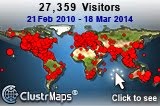I've been thinking lately about how much we all need a pat on the back sometimes. It sounds silly, a pat on the back, but it's not.
Talking to many of the teachers at my school, I sense a strong need for people to feel more appreciated. We have plenty of stress and pressure to do more, learn more, be more, but it seems we rarely take the time to revel in our accomplishments and really appreciate how far we have come.
I know that I contribute to the hyper-push for more technology. People associate me with computer problems and software frustrations. I try my hardest to be patient, to really listen to people and to meet their needs, to enjoy my job and to remain aware of what an incredible opportunity it is to be in such an exciting field.
But...
I often feel frustrated at what I see as obstacles, a need to move faster, change faster, break down the walls, so to speak, dispense with traditional teaching methods at a faster pace. I want everyone to be excited, to want to work with me, to use technology in more project-based learning. I want the freedom to try out more of my ideas. I want more time for collaboration, more time to focus on teaching, more time with the students, more time with the teachers.
So.
I dedicate this post to my co-workers at school. I think the world of you. You WILL fall in love with teaching with technology.
In the year and a half since I have worked at MJGDS:
1. We switched over to apple computers. All of the students and teachers had to learn the mac operating system. In addition to the computer lab and classroom desktops, we have two mobile labs with 10 laptops each.
2. I found an AMAZING "assistant" Kim who worked for almost an entire year as a volunteer and, although she is officially on staff this year, still volunteers most of her time. She brings so much to the school and we so very lucky to have her talents.
3. We got nine SMARTboards, 8 installed and 1 portable. I believe that we are one of the first schools in Jacksonville to have this ground-breaking technology.
4. We have started using edline for parent/student communication.
5. We started using GradeQuick Web, an online gradebook.
7. Kim and I went to FETC 2008. I presented two sessions (one on pixie, one on media blender) for Tech4Learning.
9. I have had a small measure of success in collaborating with classroom teachers on lessons and projects that integrate technology. Some of my favorites of these projects include creating blogs on Think.com for characters from The Outsiders (7th grade) and a choose-your-own-adventure story called The Outer Space Adventure (2nd grade).
10. As a random and wholly unexpected result of our school's participation in a collaborative website project called
Globaldreamers, a software company (
tech4learning, wonderful, awesome, company that shows genuine commitment to education) added Hebrew characters to their clip-art library!
12. We reused or recycled all of our old equipment (that was shoved into closets all over the school when I first arrived).
So, there are 12 great reasons for a pat on the back! There are plenty more things I could list, and there are other tech-innovators at our school besides me who have their own lists to contribute!
And now for the future. 10 goals for 2008 (for myself):
1. To engage in more collaboration with teachers, more project-based learning. That is vague. I need to define that goal further and make it an achievable goal. OK. I would like to work with at least one teacher every two months on a totally collaborative project integrating technology. My model for this is the way Deb (middle school English teacher) and I collaborated on the Outsiders blog project (now in in its second year). I will write more about this model in another blog post.
2. To set aside more time to work one-on-one with teachers to meet their individual needs and help them learn to use the technology for their own productivity.
3. To learn to podcast and start using podcasts with the students.
4. To use our new tech4learning software in creative, curriculum-driven, motivating projects.
5. To tap into more of Kim's talents as a teaching resource. She is great with the kids, and she has excellent ideas. Although she claims not to be a teacher she happens to be a very good teacher.
6. To be more patient with everyone, more caring and less frustrated. To work more on building relationships and worry less about the equipment.
7. To participate more in global collaboration with the students.
8. To work on my own website and to use it to showcase student work.
9. To create or discover high-quality webquests or other lessons for teaching copyright and information literacy (I think that is the correct term- evaluating websites, using sites like snopes before passing on emails, etc.) and to do a better job teaching these important skills to my students.
10. To guide the students to success with their technology mitzvah project. I introduced the idea to 5th grade last week, and they are very excited. I think I will create a wiki to use for brainstorming ideas and project development.













